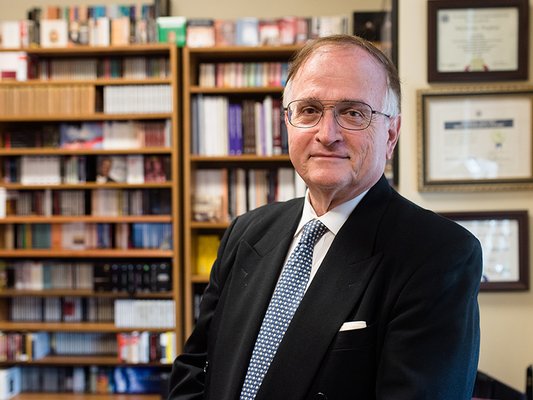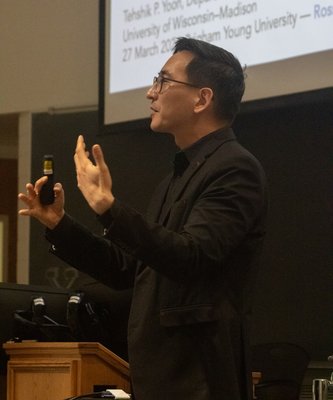Winter 2024 Lecture Review
April 23, 2024

This semester, the BYU Department of Chemistry and Biochemistry has welcomed several distinguished chemists from across the nation. With words to inspire and innovative studies to share, students and faculty have been edified by these brilliant minds who continue to expand the boundaries of chemical science as we know it.
So, let’s do a quick review.
Izatt-Christensen Lecture Series
The BYU Department of Chemistry and Biochemistry annually hosts the Reed M. Izatt and James J. Christensen Lecture Series, founded and named for two of the department’s most historically influential faculty members. This year, Dr. Frances S. Ligler and Dr. Nicholas A. Peppas presented their research over the course of three days to students of several college departments from the BYU community.
Dr. Frances S. Ligler, Chair of Biomedical Engineering at Texas A&M University’s Eppright Hall, has given much of her life to serving as a Naval Research Scientist. Involved in hundreds of publications and eleven biosensor products currently on-market, Ligler is a fellow of several prestigious institutions and has received presidential honors from both President George W. Bush and President Barack Obama. She also holds honorary doctorates from Greek and South Carolinian universities and was inducted into the U.S. National Inventors Hall of Fame in 2017.

Speaking to BYU students on March 12th and 13th, Ligler presented her research and successes with optical biosensor development. Such miniscule technology, developed with increasing sensitivity and accuracy, can be used to deeply analyze large swaths of molecular data in real-time. These sensors can be used to capture measurements and interactions between living cells, allowing analytical observation without interrupting cellular processes.
Ligler also partnered with Dr. Nicholas A. Peppas for an evening lecture titled “Small Inventions to Benefit a Big World,” where they discussed the benefits of generating and patenting chemically-based inventions while weathering the challenges of entrepreneurship. Together, they discussed how chemical inventions have positive ramifications for health care and can impact removed communities around the globe.
In addition to joining Ligler on the evening lecture of March 13th, Dr. Nicholas A. Peppas also discussed his laboratory’s research with students on March 14th in a lecture titled “Nanobiotechnology and Intelligent Biomaterials to Address and Treat Autoimmune Diseases.” Pepas serves as a chaired professor of Biomedical and Chemical Engineering, Pediatrics, Surgery, and Pharmacy at the University of Texas at Austin. He has participated in almost 2,000 publications and is involved in a plethora of institutions, patents, and start-ups. He has received recognition from several international institutions, including academies in France, Spain, Greece, Romania, Korea, and Mexico. Much of his laboratory’s work is supported by the NIH, NSF, and USAID, as well as recognition from Utah; Austin, Texas; and Portugal.

Addressing nanotechnology’s impact on treatments and medical devices, Pepas offered a deep-dive into the process of creating effective microparticles that meet the needs of the medical industry. His mantra of “from concept to clinic” guided students through the development of biosensor particles that can detect and treat a host of autoimmune diseases, including rheumatoid arthritis, Crohn’s disease, irritable bowel disease, ulcerative colitis, Sjorgen’s Syndrome, and a variety of other gastrointestinal maladies. His research continuously focuses on how to orally deliver the necessary proteins and biosensors patients need without introducing further harm.
Peppas also spoke to students on the unique responsibilities they have as BYU students. “Especially because you are at BYU,” he says, “we have an important goal…to improve the quality of life.”
“If you have an idea, talk to your major professors. Talk to people, try to apply it. Come up with something new to help people.”
Pepas is currently writing a book, Advanced Thermodynamics and Transport Phenomena in Biological Systems, through Cambridge University. It will be published and available to the public in 2025.
Bryant E. Rossiter Lecture Series
On March 26th and 27th, the BYU Department of Chemistry and Biochemistry hosted Dr. Tehshik Yoon of the University of Wisconsin at Madison as this year’s Bryant E. Rossiter lecturer. A Harvard, Berkeley, and Caltech alum, Yoon also served as an NIH postdoctoral fellow with the Eric Jacobsen laboratory and has worked for UW-Madison since 2005. A highly decorated chemist, Yoon holds a slew of awards, fellowships, and grants from organizations around the country, including Eli Lilly, Pfizer, the American Chemical Society, and the NSF. His research interests include organic synthesis, catalysis, and transition metal photocatalysis usage.
In his two-day series, Yoon discussed “Photoredox Couplings Using Base Materials” and “Stereocontrol in Photochemical Synthesis.” He described his laboratory’s efforts to expand on existing catalysis libraries to optimize reactions while maintaining economic considerations, using what was commercially available and low-cost to ketonize carboxylic acids to develop more complex catalytic compounds.

Yoon’s lecture took a fresh, honest look at his own research, discussing the setbacks and pitfalls of his laboratory’s attempts to successfully expound on their materials. Walking students through the journey, Yoon described the laboratory’s use of oxidative photochemistry, the disappointment that accompanies poor results, and the gritty persistence it takes to actualize one’s theories as a chemist. He also stressed the importance of oxidative reactions to synthetic chemistry, noted the limitations of his own technology and research, and humbly presented his advancements towards ultimately creating high-value catalytic compounds for a fraction of regular costs using base elements.
His team, in particular, found great success with Fe(III) and is continuing to study why this element seems to produce higher yields at cheaper rates with more versatile and compatible results. So far, they have discovered that FeCl3 has become the most promising because of three roles it has in reactions:
"1. Assembles in situ generated - assembles CMCt chromophore that triggers radical decarboxylation.
2. Affords benzyl chloride intermediate by radical XAT.
3. Serves as a Lewis acid that activates benzyl chloride towards substitution.”
Yoon’s laboratory is continually refining their process, developing a “two-step-one-pot protocol” that is still being tested and researched to this day.
The BYU Department of Chemistry and Biochemistry is grateful to these guest lecturers–and those who participated in regularly-scheduled seminars–for their participation in educating its students and bringing them new perspectives from around the world. We look forward to welcoming more friends of the department in upcoming 2024 seminars and are grateful for the contributions of department faculty, staff, alumni, and BYU students in making these events possible.
For a full calendar of BYU Department of Chemistry and Biochemistry seminars, please visit our lecture page at https://chem.byu.edu/academics/seminars/.